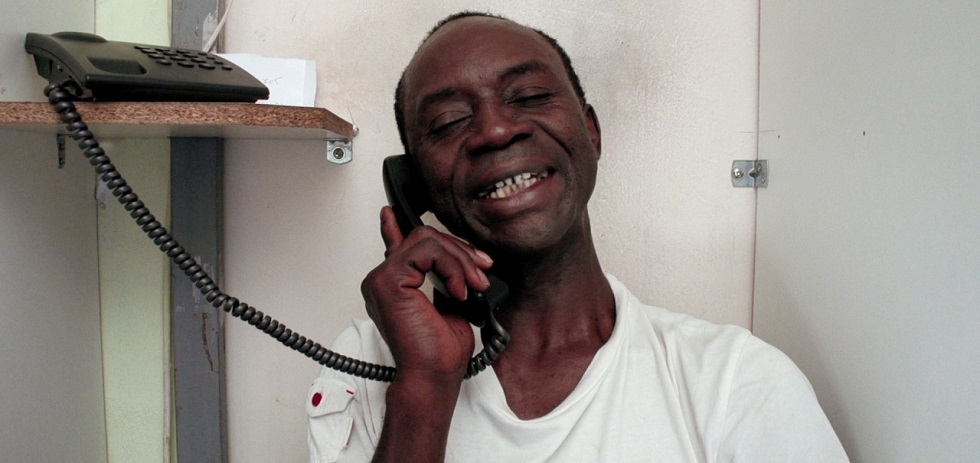With Those Who Feel the Fire Burning, first-time director Morgan Knibbe makes a bold statement about a vital international crisis, and delivers a searching exploration not only of millennial humanitarian politics, but also the ever-blurring line between documentary and fiction. The film functions as a quasi-narrative led by the disembodied spirit of a man who loses his life in a Mediterranean refugee boat sinking, but also employs extensive documentary footage to depict its narrator’s formless afterlife experience. It ultimately suffers, though, from an occasional purposelessness and a habit of straying from its content in favour of displaying its virtuoso form, diminishing some of its power as it becomes less evocative and more directly observational. Knibbe absolutely deserves credit, though, for producing an urgent and relevant work while still striving to make use of cinematic style for poetic ends.
The film, for the most part, employs real documentary footage to create a fictional story – slight though it is – centred on the ghost/spirit/shadow of its unseen lead. It’s actually a reversal of the typical format by which narrative features use actors and scripted lines to portray ‘real’ historical or political events. However, it’s the only truly staged sequence of Those Who Feel the Fire Burning that is undoubtedly its strongest. An immediate introduction to Knibbe’s swirling, cascading camera is the perfect means of depicting the chaos and panic of a stricken refugee vessel.1 We remain in the first-person view of the unnamed narrator for the entire film, but during this first scene is when the terror experienced by displaced people really hits hardest. The camerawork allows us to view others only in glimpses – a woman muttering desperately in an inaudible language, another younger passenger hopelessly hauling something across the boat – rendering the narrator’s experience both communal and, when he succumbs to the dark water, wretchedly alone. As the frame rotates again to disguise a cut from under the ocean to a night-time European highway, it’s a truly breathtaking cinematic moment.
While its meandering camera does give the film a real sense of ethereal formlessness throughout, these bravado moments of more poetic expression tend to give way as it continues. The more traditional documentary sequences which replace them, however, are also worthy in their own way, shining a light on the dank, languid world of modern refugeeism. The film seems to traverse several countries, but it’s hard to tell – the narration sounds like Arabic, but other migrants who appear speak other Middle Eastern and African languages, and road signs and police cars suggest Italy and Greece. The lack of roots put down by the documentary narrative serve to match the itinerancy of its subjects, and the endless drifting from one half-formed migrant community to the next mimics the Kafkaesque experience of those who do reach Europe.
One of the strongest sequences sees Knibbe’s camera weave through a crowd of young men waiting before dawn outside some kind of immigration office – one tells his friend that he’s been here, to this stage, before, but then his visa ran out so he has to start from the beginning. This time, or next time, he might have his stay extended legally. For Europe, ‘home’ is a tradeable commodity like anything else, and so countless people must play the game. That the narrator’s words ebb in and out of engagement with the images he ‘sees’, from dismayed thoughts of his now bereaved family to ruminations on existence itself, as well as varying in volume on the film soundtrack, also contributes to the atmosphere of hopeless chaos.
After its shattering opening, the film is basically a series of documentary vignettes tied together by the narrator’s unfelt presence, and its power from scene to scene relies heavily on the strength of each short. Along with the time it spends among young refugees waiting out their visa stays, there are also engrossing and often hypnotising segments in a makeshift mosque, where the lack of subtitling applied to an imam’s sermon gives it a desperate power, and capturing a Senegalese immigrant on a tearful phone call home. Some sequences are less effective, though, and the film is at its worst when it simply stares motionless at one of its subjects, seeming to expect that the very act of filming impoverished people is enough for the viewer to arrive at a deep and meaningful conclusion about asylum politics. For a film so brief, at an hour and a quarter, these losses of focus are infuriating in what is otherwise an engaged and surprisingly visual work. With a vital social message presented to patchy but occasionally devastating effect, Those Who Feel the Fire Burning could have drawn deserved praise as a largely stylistically unadventurous documentary piece. It stands out, though, because of its willingness to meld elements of the essay film, cinematic spiritualism, and kaleidoscope cinematography into a pulsating work of cinema verite.

